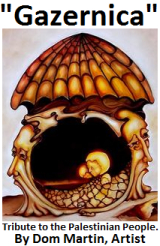
Publisher:
Bonnie King
CONTACT:
Newsroom@Salem-news.com
Advertising:
Adsales@Salem-news.com

~Truth~
~Justice~
~Peace~
TJP
Feb-23-2012 20:36

 TweetFollow @OregonNews
TweetFollow @OregonNews
Feature: Guadalajara, Guadalajara
Kent Paterson for Salem-News.comViolence and drugs, historic culture and politics...
 Courtesy: fotomusica.net |
(LAS CRUCES, NM) - In Guadalajara, two men recently played deejay in front of city hall. Strategically positioned across from the entrance to the old building, they directed a barrage of recordings at the staid government offices.
Added to a play list of classic protest music from the Latin American New Song Movement of the 1970s, newer tunes with a socially-conscious tinge broke the brisk Tapatio morning. Songs soared like Manu Chao’s “Clandestino” and Panteon Rococo’s “Minimum Wage,” as well as the lyrics from Molotov’s sarcastic tribute to politicians: “Gimme the power,” “gimme the power….”
Joining his colleague from a teachers’ union, the leader of a group of Guadalajara bus workers took time to explain the graphics and sets of numbers that were neatly scrolled on a big banner laid out on the pavement.
According to the SISTECOZOME union, the state and city could save a lot of money by purchasing electrical trolleys instead of diesel-fueled buses. Although at nearly $300,000 a unit the trolleys cost more than three times the price of a diesel bus, they last nearly eight times longer, according to the union.
“There’s enough money” for the investment, asserted Hector Ramos, union secretary. Fired from his job, Ramos and other bus drivers have been at loggerheads for months with the state officials who run their bus system.
 |
The union activist said co-workers seek enrollment in the Social Security system and the creation of a mutual fund. Currently, fellow bus drivers are paid 20 percent of the daily fares, which might come to about $40 salary per day before deductions, Ramos said. The pay is significantly higher than many workers receive in Guadalajara, but still poses a challenge for someone trying to raise a family in this expensive city.
The protest staged by Ramos’ organization is an example of how public transportation issues in Mexico frequently mesh labor-management issues with larger social and environmental ones.
Moving millions of people around Mexico’s second-largest city every day is a formidable task. Roaring down wide boulevards and veering into the working-class neighborhoods, buses then pass small hardware stores, mom-and-pop groceries, auto parts outlets and eateries where the smell of roasting chickens spices the hustle and bustle. Graffiti covers residences and businesses alike, seemingly thrusting Guadalajara into a competition with Morelia, Michoacan, for winner of the most-splotched city contest.
Several bus lines converge in the old colonial center of the city, an expansive place glazed with stone churches, old convents, shady parks and pleasant plazas.
Foreign-owned banks, upscale fashion stores, low-brow markets, legions of pirate DVD street vendors and shoe stores galore make up the commercial action. Leather-jacketed young women, carefully groomed business types, mothers and daughters, cholos and indigenas all stroll down the streets of the Jalisco state capital. Their eyes glued to the cell-phone, young people half-blindly navigate the paths over crumbling sidewalks and gutted streets. Big Internet cafes with rows of individual booths like the busy office of yesteryear invite cyber-surfers, chatters and scammers.
Burger King, Seven-Eleven, pizza joints, crepe stands and donut counters all entice the modern, roving diner, even as bites of traditional Mexican food like tortas ahogadas, Jalisco-style sandwiches bathed in a sauce, are still available for the curious.
An ever-expanding corps of all-you-can-eat Chinese buffets tempts the truly hungry. At the Chong Wah restaurant, a Chinese immigrant addresses a steady flow of customers in her accented Spanish. The eatery charges a little less than five bucks plus drink, though children under three feet of height, regardless of age, can eat without charge.
As dusk fell on a recent day, the revelers and lovers sprung into action. In an open air downtown bar, a couple slow-danced to a John Lennon great. “Love, love. love…” Over at the new Casino Havana, the security men scrambled into position. The package of gambling , sex and Cuban music is a nostalgic throwback to pre-revolutionary 1959 when Cuba was run by mafia men and their minions. Only this time the fun and games are in the heart of the Mexican Republic.
 The Palacio Municipal (Guadalajara's City Hall, or municipal building). |
Back in front of Guadalajara City Hall, music titillated the evening. A bandleader led an orchestra of black-suited musicians in a concert that included renditions of “Jalisco Marches” and “An Italian in Algeria.”
On the other side of the plaza, stood the makeshift camp of the Garibaldi Movement. Resembling the Occupy camps that proliferated across the United States before they were systematically dismantled by police last fall, a pair of tents surrounded by protest signs, photo essays and candles evoked a variety of issues and causes ranging from opposition to the North American Free Trade Agreement to ending the so-called drug war. Scrawled paper messages were faded from the recent rains, but a sign from last Christmas had survived: “The politicians and business people are going to eat turkey today. What are you going to eat?”
Another sign read: “Sin Maiz, No Hay Pais” (“No Corn, No Country.”)
Unlike their counterparts in the United States, the Mexican authorities have not cracked down on the camp so far.
A handful of guardians chatted with passerby and explained the goals of their movement. Organized late last year, the protest, or planton as it is known in Mexico, has attracted support from scores of young people who come and go. Activists organized a hip hop festival, staged street theater and sponsored workshops on bullying and raised awareness about violence against women, said camp spokesman Jose Luis Diaz.
In honor of the fallen, the protestors have erected three crosses dedicated to student activists Carlos Sinhue, murdered in the Mexico City area last year, and Gabriel Echeverria de Jesus and Jorge Alexis Herrera, both slain by Guerrero state police during a December protest in Chilpancingo
According to Diaz, the Garibaldi Movement is a transnational network with adherents in Mexico, the United States and Canada. The movement takes its name from the 19th century Italian nationalist and revolutionary Giuseppe Garibaldi. His grandson Jose later fought in the 1910 Mexican Revolution. Garibaldi and his family were forerunners of internationalists like Che Guevara, Diaz contended, adding that the contemporary movement finds inspiration in the Italian rebels of old. “There are no borders, just like it was for the Garibaldis,” Diaz said.
The Garibaldi Movement has drafted a petition of redress, proposing short-term solutions to the crisis of capitalism like unemployment insurance and community kitchens, Diaz said. The demands have been presented to all three levels of government but until now no authorities have responded, he added.
Violence is a central issue of the protest.
“Jalisco is one of the states where femicide has increased, not just in Ciudad Juarez,” Diaz said. Some visitors share their own personal stories of the generalized violence unnerving Guadalajara but many people are too intimidated to participate, the long-time left activist said. “People are afraid ,” Diaz said of the current mood in his city. “There are many disappeared,”
Left by friends, a big picture of young Jonathan Martinez was displayed in a prominent place at the front of the encampment. The up-and-coming leader of a Guadalajara norteno group, Banda La Excelencia, Martinez was reported murdered after a show at a local club in January 2011. Press accounts said Martinez was slain by killers who were pissed off that his group would not perform another encore. They then expressed their dissatisfaction by tossing a grenade and firing off an automatic weapon.
By most accounts, criminal violence surged in Guadalajara after drug lord Nacho Coronel, who was reputed to control the huge plaza, was gunned down by the Mexican government in 2010.
The most jeering incident happened last November, when the bodies of 26 men were found one morning stacked in three trucks parked near the emblematic Millenium Arches. The men, presumed victims of a Zetas raid into the heart of their rivals’ territory, were dumped at a location not far from the famous Expo Guadalajara, where the annual Guadalajara International Book Fair (FIL) was scheduled to open just days later. Ironically, Mexican violence has been a big topic discussed at the FIL in the last few years.
Painted in surrealistic style, a piece at the Garibaldi Movement planton depicts an anguished face grimacing above the arches and three trucks.
Analysts like the Texas-based, private intelligence firm Stratfor emphasize Guadalajara’s role as an industrial producer and exporter of methamphetamines. The Mexican army’s confiscation of 15 tons of crystal from a nearby ranch earlier this month certainly fits this view, though the hard historical evidence might be lacking in the future. The multi-ton load of seized ice was incinerated by the federal attorney general’s office only ten days later on February 17.
In a way, the revelation of Guadalajara as a mass producer of dope is not surprising. The city has long excelled at manufacturing products for national and international markets-tequila, candies and Smartphones to name just a few.
A circular, historical trajectory now connects the lonely highways of the United States, the withered flowers of Haight-Ashbury, the doomed dreams of New Mexico, the hidden graveyards of the San Joaquin Valley’s “Speed Freak Killers” and the land of tequila and mariachis. In an age of violence and fast living, nothing is perhaps more anthropologically representative than the human and social wreckage of speed.
Tomas Espinoza is no stranger to violence. A Garibaldi Movement supporter and an activist with the Gay Citizens and Friends Front, Espinoza had a brother-in-law, Enrique Perez, who was killed by the government back in 1976 in Sinaloa. Perez was a revolutionary who was slain in a confrontation with the federales at a Culican safe house, Espinoza said. He left behind a son named Ernesto Marx.
Espinoza credited his brother-in-law and comrades for helping spark an awareness about the state of the world: “They didn’t want so many poor people and a bad distribution of wealth.”
Nowadays, Espinoza advocates on behalf of the trans-sexual sex workers who ply their trade in Guadalajara’s downtown but have been targets of violence during the last two years. A friend was murdered and his body burned, Espinoza lamented. The Gay Front has documented at least 20 cases of murder or extreme violence against sex workers in Guadalajara, he said.
Overall, the locals are shocked, numbed and angry about the violence that has swirled around them, said Jose Luis Diaz. “There is great discontent with the violence,” he added. “Like us, people are indignant and fed up.”
-Kent Paterson
Frontera NorteSur: on-line, U.S.-Mexico border news
Center for Latin American and Border Studies
New Mexico State University
Las Cruces, New Mexico
 |
 |
 |
 |
 |
Articles for February 22, 2012 | Articles for February 23, 2012 | Articles for February 24, 2012
Quick Links
DINING
Willamette UniversityGoudy Commons Cafe
Dine on the Queen
Willamette Queen Sternwheeler
MUST SEE SALEM
Oregon Capitol ToursCapitol History Gateway
Willamette River Ride
Willamette Queen Sternwheeler
Historic Home Tours:
Deepwood Museum
The Bush House
Gaiety Hollow Garden
AUCTIONS - APPRAISALS
Auction Masters & AppraisalsCONSTRUCTION SERVICES
Roofing and ContractingSheridan, Ore.
ONLINE SHOPPING
Special Occasion DressesAdvertise with Salem-News
Contact:AdSales@Salem-News.com


googlec507860f6901db00.html


Terms of Service | Privacy Policy
All comments and messages are approved by people and self promotional links or unacceptable comments are denied.
[Return to Top]
©2025 Salem-News.com. All opinions expressed in this article are those of the author and do not necessarily reflect those of Salem-News.com.